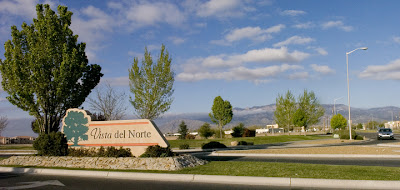 This is the entry to the Vista Del Norte development on Osuna Road.
This is the entry to the Vista Del Norte development on Osuna Road. A few weeks back there was an uproar at city council over the 22-acre undeveloped lot between the homes and Osuna.
A few weeks back there was an uproar at city council over the 22-acre undeveloped lot between the homes and Osuna.The owners of the property negotiated with Wal-Mart to build a super store on the property. A lot of “not in my backyard” and anti Wal-Mart protesting surfaced.
 It seemed like there was no way to stop the development because the land that Wal-Mart and the landowner propose using is appropriately zoned. However, out of the blue, as in out of the blue sky, comes a balloon or a thousand balloons to land in one of the last large, vacant tracts in the north valley.
It seemed like there was no way to stop the development because the land that Wal-Mart and the landowner propose using is appropriately zoned. However, out of the blue, as in out of the blue sky, comes a balloon or a thousand balloons to land in one of the last large, vacant tracts in the north valley. The lot is south of Albuquerque Balloon Fiesta Park where for nine or ten days a year, hundreds of hot air balloons launch.
The city council, in an extraordinary procedural move, introduced the matter for immediate action and voted on legislation without the benefit of committee deliberation or extended public debate.
The bill, introduced by Councillor Deborah O'Malley, will also provide for recreational fields under the control of the Parks and Recreation Department. The action passed 8-0 with Councillor Sally Mayer excused.
In the spirit of open disclosure, I have been a licensed commercial balloon pilot for 27 years and have watched the Balloon Fiesta change it’s launch sites in a steady northward march, leapfrogging across the city.
The first balloon event was not officially known as Fiesta. It was in 1972; the 50th anniversary of KOB radio held on what is now the west parking lot of Coronado shopping center. The next year’s event was a world hot air balloon championship. It was held on the infield of the racetrack at the New Mexico State Fairgrounds and the following year the designation of Balloon Fiesta came into existence and was held at the same venue.
 The Fiesta then moved to Singer field, seen left, in 1976 during my first balloon ride, just northwest of Jefferson St. and I-25. Several years later it moved about a mile or so north to an unused gravel pit called Cutter field in honor of one of the founders of Albuquerque ballooning, Sid Cutter. It moved again to a former landfill that was designated as a city park just south of Alameda Blvd. The launch site moved one last time to its permanent location at the northern edge of the city, abutting against Sandia Pueblo. The land was designated as Balloon Fiesta Park and developed and grassed over. It doubles as a golf driving range when the balloons don’t fly. The south end of the park is the home to the Anderson-Abruzzo Albuquerque International Balloon Museum.
The Fiesta then moved to Singer field, seen left, in 1976 during my first balloon ride, just northwest of Jefferson St. and I-25. Several years later it moved about a mile or so north to an unused gravel pit called Cutter field in honor of one of the founders of Albuquerque ballooning, Sid Cutter. It moved again to a former landfill that was designated as a city park just south of Alameda Blvd. The launch site moved one last time to its permanent location at the northern edge of the city, abutting against Sandia Pueblo. The land was designated as Balloon Fiesta Park and developed and grassed over. It doubles as a golf driving range when the balloons don’t fly. The south end of the park is the home to the Anderson-Abruzzo Albuquerque International Balloon Museum. 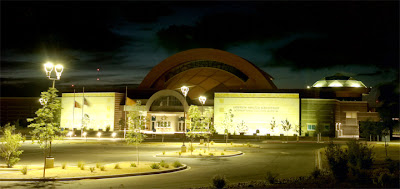 I indicated to my readers that if I ever used some extraordinary or manipulative photographic technique I would disclose it. This picture is a composite of several exposures brought together in the computer with the PhotoShop program using a technique call high dynamic range. It allows for the darkest portions to show detail and the brightest portions to not blow out. The camera’s normal exposure latitude would not allow for such a wide range. The picture however, is consistent with what the human eye can see.
I indicated to my readers that if I ever used some extraordinary or manipulative photographic technique I would disclose it. This picture is a composite of several exposures brought together in the computer with the PhotoShop program using a technique call high dynamic range. It allows for the darkest portions to show detail and the brightest portions to not blow out. The camera’s normal exposure latitude would not allow for such a wide range. The picture however, is consistent with what the human eye can see. In all my years of flying I never landed in that location. The closest I came once was about a half mile to the northwest, when I had taken off from the West Mesa. Balloons have no steering device and can, at best, only be coaxed to alter directions by finding differing winds at different altitudes.
I stopped launching from the Fiesta field in 2000 because I was not satisfied that it was still safe to fly over congested areas. Homes and business buildings continued filling in vacant land in the northern part of town.
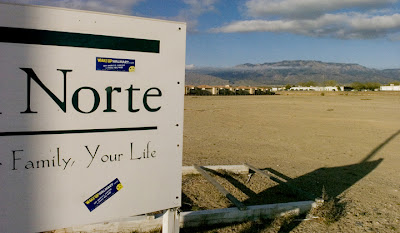 Without supporting Wal-Mart or bashing Balloon Fiesta, there is a section of the Constitution, also applying to the city that is troubling. Article I, Section 9. 3. “No bill of attainder or ex post facto law shall be passed.” A bill of attainder is a piece of legislation designed to benefit a particular person or entity, while an ex post facto law is a piece of legislation written to take effect to encompass a time before the law was written.
Without supporting Wal-Mart or bashing Balloon Fiesta, there is a section of the Constitution, also applying to the city that is troubling. Article I, Section 9. 3. “No bill of attainder or ex post facto law shall be passed.” A bill of attainder is a piece of legislation designed to benefit a particular person or entity, while an ex post facto law is a piece of legislation written to take effect to encompass a time before the law was written.The City Council’s action raises questions about using the right of eminent domain, the ability of a government to take property for a needed public purpose. This is generally accepted as necessary for building roads, bridges and schools. The Supreme Court upheld a town’s right to condemn property and turn it over to developers because the development would bring in higher tax revenues. There was a loud backlash and several states have outlawed the practice.
New Mexico is not one of those states and Rio Rancho, in particular, is using the right of eminent domain to take land purchased years ago. people were not allowed to develop their land. The City of Rio Rancho then, instead of exercising the power themselves’, farmed it out to the developer who stood to gain. The developer, with a vested interest, manipulated the assessed value of the properties virtually under paying the owners for the land. These property owners stood to gain substantially more had they been allowed to develop their land or if it had sold on the open market.
Expect a protracted legal battle and for those unfamiliar with the dynamics of balloon flight, a pilot is very limited in the ability to direct the movement against the wind’s direction.
The Journal editorial supported the action, calling for places for the balloons to come down. However ironic it might be, the Journal does not allow balloons to land on their property.
The City had not considered the site as a park prior to the Wal-Mart deal coming to light.
 Rumble-strips
Rumble-strips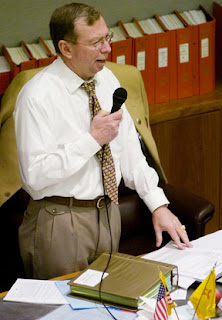 Mayor Martin Chávez and Chief of Police Ray Schultz are bemoaning the fact that Gov. Bill Richardson signed a bill sponsored by Sen. William H. Payne R- Bernalillo County, left, requiring notification to approaching drivers just before red light and speed camera controlled intersections.
Mayor Martin Chávez and Chief of Police Ray Schultz are bemoaning the fact that Gov. Bill Richardson signed a bill sponsored by Sen. William H. Payne R- Bernalillo County, left, requiring notification to approaching drivers just before red light and speed camera controlled intersections. The governor vetoed another bill that had passed by huge margins in both houses of the state legislature. It would have required that fines collected by the city’s “civil” process and administrative hearing officer’s procedures, go through the courts fee system to help pay down the bonds for the Metropolitan Court building. Sen. Timothy Z. Jennings, D - Chaves, Eddy, Lincoln and Otero counties, below, complained that by allowing Albuquerque to retain the proceeds of the Safe Traffic Operations Program, the rest of the state was having to unfairly fund a greater portion of the Metropolitan Court.
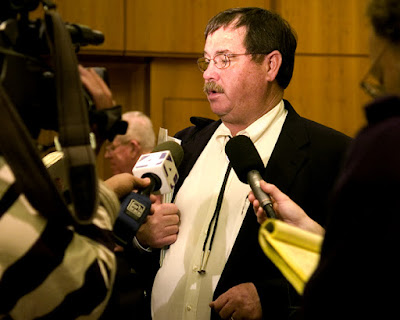 The mayor reportedly says that installing warning lights would cost $250,000 per intersection for the 20 camera systems now in place. That is a number that some critics say might be inflated by a factor of, as high as 10. According to Albuquerque Police Department Public Information Officer John Walsh, the cost of installing the cameras themselves is $35,000 per intersection. Installing flashing lights would require similar engineering and construction costs. The ballpark figure should not exceed $40,000 per location.
The mayor reportedly says that installing warning lights would cost $250,000 per intersection for the 20 camera systems now in place. That is a number that some critics say might be inflated by a factor of, as high as 10. According to Albuquerque Police Department Public Information Officer John Walsh, the cost of installing the cameras themselves is $35,000 per intersection. Installing flashing lights would require similar engineering and construction costs. The ballpark figure should not exceed $40,000 per location.  The state law offered an alternative, the use of rumble-strips. Chief Schultz claims that the use of rumble-strips poses dangers of their own to motorcyclists and vehicles that use anti-skid braking systems. Both claims are untrue.
The state law offered an alternative, the use of rumble-strips. Chief Schultz claims that the use of rumble-strips poses dangers of their own to motorcyclists and vehicles that use anti-skid braking systems. Both claims are untrue.Having been a motorcyclist and knowing a number of riders, no self respecting experienced rider would admit that a set of rumble strips would adversely affect them. Having been an anti-skid braking systems instructor at the police academy, a 20-30 foot patch of rumble strips would pose no major problem for a vehicle, even under a panic stop. The pulsating feature of ABS simply kicks out and normal braking takes over. It is no worse than for a vehicle that is not ABS equipped.
Within the recently renovated Big-I interchange complex, maintained by the New Mexico Department of Transportation, the roads have both rumble-strips and flashing warning lights. They were after thoughts installed because of accidents.
 There are two sets of rumble strips on the westbound I-40 exit to University Blvd. and on the north frontage road west of University. There is a flashing warning light on the west frontage just north of Mountain Road because there is a hill that obstructs the view of the traffic control signal light. There were two fatal crashes within months of it’s opening where the southbound drivers who ran the red light claimed, that upon cresting the hill, were surprised by the existence of the red light, and could not stop or avoid the collision.
There are two sets of rumble strips on the westbound I-40 exit to University Blvd. and on the north frontage road west of University. There is a flashing warning light on the west frontage just north of Mountain Road because there is a hill that obstructs the view of the traffic control signal light. There were two fatal crashes within months of it’s opening where the southbound drivers who ran the red light claimed, that upon cresting the hill, were surprised by the existence of the red light, and could not stop or avoid the collision.  There are federal standards regarding virtually every aspect of road design and traffic controls that the states and city must follow.
There are federal standards regarding virtually every aspect of road design and traffic controls that the states and city must follow. Though Chávez claims that the only reason for the existence of the automated enforcement is safety, he is not willing to do reasonable things that might also reduce violations.
Chávez and Schultz held a press conference Monday, where Chávez announced traffic engineering was ordered to extend the yellow light timing by a half second at camera controlled intersections. I did not attend the press conference only because both the mayor and chief’s public information officers refuse to honor my repeated requests to be notified of such events,

Imus – Free Speech
 Don Imus got sacked from his highly rated CBS radio and simulcast MSNBC television show, for his racist and misogynist rant of a couple of weeks ago.
Don Imus got sacked from his highly rated CBS radio and simulcast MSNBC television show, for his racist and misogynist rant of a couple of weeks ago.Many felt his firing was proper while some have called it a violation of his free speech.
One needs to ask a couple of questions about assessing the free speech issue.
Imus, like everybody else in this country, is protected from government censorship. Imus lost his job because his employers, not the government, took back their microphone.
The Constitution only prohibits congress from writing laws that abridge the freedom of speech. The Constitution does a couple of things; it sets up and restricts government, and it outlines a capitalist theory.
Imus ran afoul of the capitalist theory. His language offended people who told his sponsors that they would no longer purchase their products and the businesses chose to distance themselves from him. It was a profit motive based decision and CBS/MSNBC also chose to follow such a business model in releasing Imus.
His free speech right hasn’t been affected. He can scream at the top of his lungs and rant any outrageous thing he wants; you’re just not going to hear him from the same place you used to on your radio dial.

Speaking of free speech…
A fellow local blogger, Eye on Albuquerque, http://eyeonalbuquerque.blogspot.com/, has been tracking several issues within the City of Albuquerque’s government. Recently, the anonymous blog has raised ethical questions and factual discrepancies surrounding the city’s 311 - information center’s manager Michael Padilla, who was recently assigned to additionally take over the management of the 911 emergency center.
Padilla, 28, has no law enforcement background, training or experience and made some bold assertions about how he was going to change the 911 - center and make it as efficient as the 311 - operation. He simply had no idea of why 911 works differently.
 Sources, whom I will not identify, because they fear retaliation, have for years indicated the problems inherent in the 911 operations. Chávez removed Deputy Chief of Police Joe Silva, right, from operational control over the 911, even though Silva had forwarded upwards of 45 memorandums delineating deficiencies and seeking approval to make corrections, but was specifically denied permission and funding to make change. Silva retired.
Sources, whom I will not identify, because they fear retaliation, have for years indicated the problems inherent in the 911 operations. Chávez removed Deputy Chief of Police Joe Silva, right, from operational control over the 911, even though Silva had forwarded upwards of 45 memorandums delineating deficiencies and seeking approval to make corrections, but was specifically denied permission and funding to make change. Silva retired. Padilla’s ignorant and arrogant attitude aggravated and alienated some working at the 911 communications center. Questions of Padilla’s status arose. Was he certified by the State’s Department of Public Safety as having been trained and received a 911 and dispatcher certification and had he completed the FBI’s National Crime Information Center training? There was some speculation, because he was not a police employee, as to whether he was subjected to the rigorous background check that all other APD employees go through.
Padilla faced allegations of sexual harassment and creating a hostile work environment, and after an internal investigation, he was suspended for 30 days.
The Eye also revealed, according the City Clerks website, a Michael Padilla had made a $4,000 contribution to Chávez’ 2005 mayoral campaign, just weeks before he got the 311 manager’s job. The Eye speculated that when Padilla got the job, it was based on their assessment it would have taken a month or two to set up the unit. However, a long time employee familiar with telephone communications services with the public had done the lion’s share of preparation in the previous months for the call center. She was never publicly recognized for her efforts.
With Monday’s resignation of Padilla, the Eye raised another point: that Padilla was setting up a consulting firm and was angling to get a future city contract to continue working on the 911 management issues.
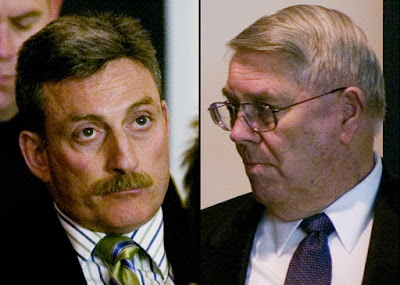 Chávez reorganized the chain of command structure of the 911 center. He removed Deputy Chief Michael Castro, left, and replaced him with Civilian Executive Deputy Chief Joe Bowdich, right. A Michael Castro is listed as making a $3,000 contribution to Chávez in 2005, on the City Clerks website.
Chávez reorganized the chain of command structure of the 911 center. He removed Deputy Chief Michael Castro, left, and replaced him with Civilian Executive Deputy Chief Joe Bowdich, right. A Michael Castro is listed as making a $3,000 contribution to Chávez in 2005, on the City Clerks website.The mayor also assigned Assistant City Attorney Pete Dinelli and Chief Administrative Officer Bruce Perlman to implement all of Padilla’s recommendations for the 911 center.
Dinelli has a long history with city policy making. I first met him as a rookie City Councillor when he took office Dec. 1, 1985 and I was the newly elected police officers association president. We spent many an hour discussing the role of public oversight of police.
He wanted civilian control over the internal affairs and disciplinary process.
We sat on an internal committee together, looking into whether there should be more civilian police oversight. The Albuquerque Journal ran a weeklong series called, “Policing the Police.” The committee decided to invite the Journal’s editor to come to express their concerns based on their series. Instead, an investigative reporter, Art Geiselman came to observe and report on the committee. Police administrators refused to continue the meeting as a public meeting. Dinelli and I wrangled with Chief Sammy Baca over the requirements of the Open Meetings Act. The meeting was cancelled when Baca chose to ignore our warnings.
Dinelli pushed very hard and the police union pushed back. Dinelli eventually compromised and twenty years later, much of what he originally proposed, has come to fruition, though many of the points that police officers objected to have never been implemented. The internal affairs and disciplinary procedures are still under the ultimate control of the chief of police, but there is also an independent review officer and a police oversight commission.
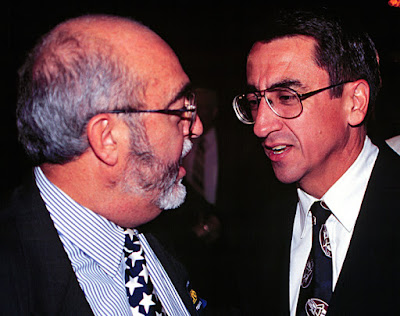 This is Dinelli, seen right, celebrating Jeff Romero’s election as Bernalillo County District Attorney in 1996. The greatest political foible I ever made was answering directly a question from my former personal lawyer, Romero, left, without adding my own take. Romero was considering hiring Dinelli as his Chief Deputy District Attorney. He asked me how the police would feel about Dinelli, knowing there had been some animosity. My answer was that those officers who would remember Dinelli from more than 10 years earlier were probably retired or had not been involved with him. My mistake was not saying that Dinelli probably had not changed and could strain relationships with police again. I regret not having spoken my mind. Romero appointed Dinelli. Not only did Dinelli strain relationships with the cops, he became a hatchet man within the DA’s office destroying morale, running off career prosecutors, and alienating the defense attorney’s community to the point that he publicly ruined any hope of Romero being reelected.
This is Dinelli, seen right, celebrating Jeff Romero’s election as Bernalillo County District Attorney in 1996. The greatest political foible I ever made was answering directly a question from my former personal lawyer, Romero, left, without adding my own take. Romero was considering hiring Dinelli as his Chief Deputy District Attorney. He asked me how the police would feel about Dinelli, knowing there had been some animosity. My answer was that those officers who would remember Dinelli from more than 10 years earlier were probably retired or had not been involved with him. My mistake was not saying that Dinelli probably had not changed and could strain relationships with police again. I regret not having spoken my mind. Romero appointed Dinelli. Not only did Dinelli strain relationships with the cops, he became a hatchet man within the DA’s office destroying morale, running off career prosecutors, and alienating the defense attorney’s community to the point that he publicly ruined any hope of Romero being reelected. Dinelli has worked for the Chávez administration and is currently Deputy City Attorney heading the Safe City Strike Force, leading the closing down of old motels and pursuing vandals and taggers through civil suits in District Court. He is one of the architects of the public nuisance abatement theory. Unlike the motel and vandals who are pursued in court, he favors a “so-called civil process,” bypassing the courts using an administrative hearing process. He uses this “so called civil process” for actions that the city has no administrative authority over, rather than using criminal law to enforce city ordinances.
Perlman, a professor of public administration, has a long history with the police department starting in the late ’70s, working with the planning unit. The current Chief Public Safety Officer Nick Bakas, seen here below, on the left with police chaplain Jack Price in 1977, was an officer assigned to planning with Perlman.
 Perlman, lower right, was interested in police work, attended the police academy as a volunteer reserve officer and worked the streets.
Perlman, lower right, was interested in police work, attended the police academy as a volunteer reserve officer and worked the streets.  The communications section of APD has had systemic problems and has developed its own cultural values that do not always serve the public, the department and ultimately the officers on the street, as well as they should. There are wonderful professional people in communications, but not all that they do is the best that they could do.
The communications section of APD has had systemic problems and has developed its own cultural values that do not always serve the public, the department and ultimately the officers on the street, as well as they should. There are wonderful professional people in communications, but not all that they do is the best that they could do.A radical change might be in order, however, how the mayor’s upper management staff attempts to deal with these problems could just as easily cause more problems than they solve.
The Eye reports that Deputy Chief Castro ordered Capt. David Depies the task of unmasking the identity of the Eye.
If true, the Eye is rightfully pissed.
2 comments:
My father Art Geiselman always felt that the Police Dept was not serving the needs of the citizens of Albuquerque. He was not just an investigative reporter but a true crusader for corruption .
Post a Comment